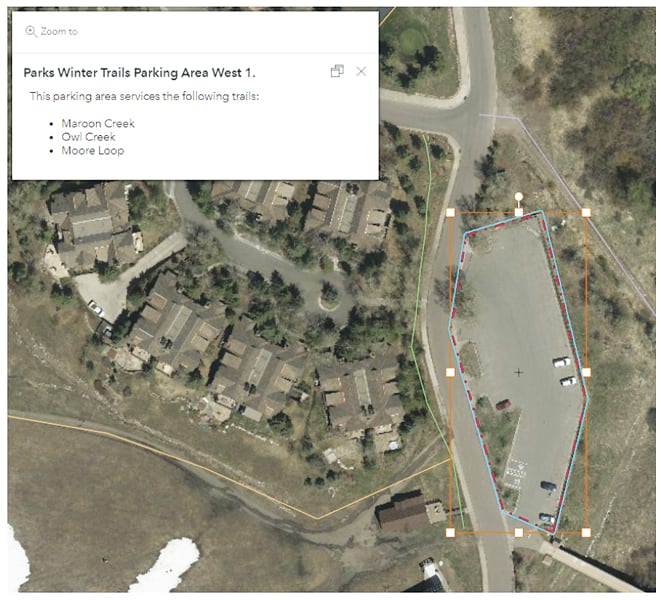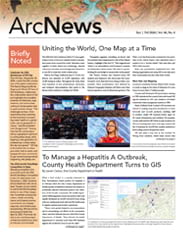Several years ago, the GIS team for the City of Aspen was stretched thin. Other municipal departments in the famed Colorado ski resort community heavily relied on the team for maps and geospatial information, and city leaders weren’t fully aware of the role GIS could play in city operations or all the services that the team was providing.
To help transition city employees to a self-service GIS model while elevating city leadership’s GIS awareness, Aspen GIS manager Bridgette Kelly and her team partnered with Esri Training Services. Aspen has a small-government enterprise agreement with Esri and is a member of the Esri Advantage Program. Kelly used Advantage Program credits to purchase custom training and deploy a tailored technology adoption strategy, which her team named the GIS User Expansion Initiative.
In the initiative’s first phase, Kelly commissioned a custom web course that prepares employees to leverage the capabilities of a Viewer user type license. The course, which she calls the “viewer course,” shows how to access Aspen’s GIS portal, navigate the portal’s rich collection of GIS content, and find the information needed to answer questions and support work projects.

Kelly also consulted with an adoption strategy expert to engage city leaders. Together, they crafted a communications strategy and a presentation that Kelly delivered to department managers showing how her team directly supported their projects while aligning with city priorities.
This two-pronged approach was well-received. Since the web course was launched and widely promoted, the portal has attracted almost 300 users. Leaders have gained a deeper understanding of how GIS benefits their department and the community as a whole.
Expanding the Expansion Initiative
Having achieved their initial goals, Kelly and her team began the next phase. Their new objectives were to embed GIS into the city’s onboarding process and support employees interested in exploring more advanced GIS capabilities. Kelly worked with the city’s human resources department to connect with new employees during their first month on the job.
“Even if they never create their own map or use GIS analysis tools, most city employees are going to need to look up information—where is a certain address, who owns this property, and so on,” Kelly said. “We want to make sure everyone knows the portal is there, has access to it, and can leverage the content in there.”
The GIS portal is one of a suite of enterprise-wide apps that new employees can access starting on their first day.
“Employees use a single sign-on application to access their time sheet and other essential city applications,” Kelly said. “New employees see our GIS portal right there, bundled with those essential applications, and they click on it and are curious.”
When a new employee accesses the portal for the first time via the single sign-on app, they are automatically assigned a Viewer user type license.
“Meeting with employees early in their onboarding process to explain exactly what it is they’ve been clicking on has been very useful,” Kelly said.
Each month, she introduces new employees to GIS using an ArcGIS StoryMaps story. During the meeting, Kelly invites them to take the viewer course, shows them how to create an ArcGIS public account so that they can access the course via Esri Academy, and connects them to Aspen’s My Esri organization.
Because the viewer web course is housed in an Esri Academy private catalog that Kelly administers, she has tools to track employee enrollments, progress, and completions.
Kelly includes summer interns in her GIS onboarding process because they often perform mobile work using ArcGIS Field Maps or ArcGIS Survey123.
“On day one, we get them set up with the portal and into the training because we want them to hit the ground running,” she said.
Growing Viewers into Creators
While all Aspen city employees now have a baseline awareness of GIS and the city’s GIS portal, some want to create their own content. To support these employees, Kelly commissioned a second custom web course, which she calls the “creator course.”
“We met with the Esri team and put together an outline of all the portal items that we wanted to be available within the course, and then we chose certain feature layers for use within the exercises,” Kelly explained.
The two-hour course contains conceptual information and exercises to teach learners to access the portal and its feature layers, as well has how to create and edit features, make and share web maps, and annotate a web map using a sketch layer. Exercise screenshots match what learners see in the GIS portal.
Similar to the viewer course, the creator course is hosted in a private catalog on Esri Academy, which means it is accessible only to Aspen city employees. To promote the creator course and the benefits of expanded portal capabilities, Kelly reached out to employees who had taken the viewer course.
And, as she did during the initial phase, Kelly infused fun into employee outreach activities to increase engagement. The first five people to send her their course certificate of completion received a voucher for free cookies.
Whether motivated by a thirst for knowledge or a hunger for sweet treats, by mid-2024, 93 city employees had completed the creator web course.
Enabling Innovation Through Education
Kelly is pleased by city staff’s increased engagement with GIS, as well as higher GIS awareness among city leaders.
“We’re promoting that GIS is a tool that should be available to everyone in the organization in order to increase their efficiency and improve their workflows and just gain more information quickly,” she said.
City leaders have also been influenced by the GIS User Expansion Initiative.
“The public works director and city manager presented a new GIS permitting application to the city council on their own. They told me they didn’t need me there,” Kelly said with a laugh. “There’s a lot of construction activity and a lot of permits being submitted, [and] this application allows city staff and the public to visualize where all the permitting activity is. This is a very big topic in the community.”
Kelly has been delighted by the transition to broad engagement with GIS at the City of Aspen.
“It’s really nice to see,” she said.

